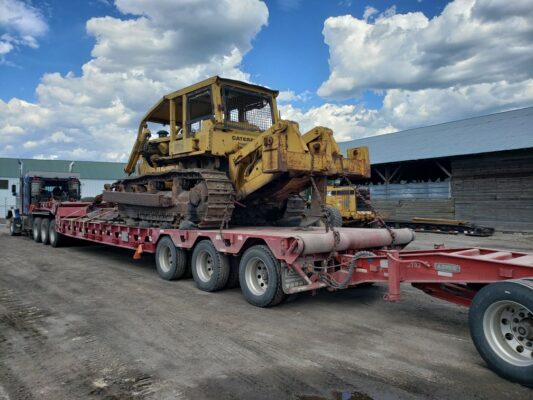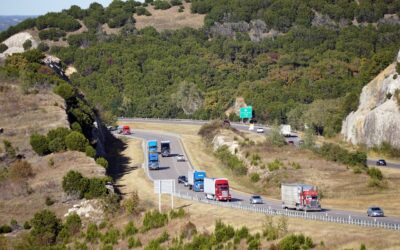Loading and unloading procedures for transporting heavy equipment require attention, precision, and experience. It can also be a risky and complicated process. For the safety of your equipment, workers, and drivers on the road, it’s essential to be thorough and accurate in hauling any equipment. Whether you are transporting construction equipment, forestry machinery, or oversized loads, proper loading and unloading processes are essential.
Safe loading can help ensure machinery arrives in good condition and will reduce the risk of injury during this process. Additionally, when unloading equipment or heavy machines, there is an increased risk of damage to the machine or workers if the initial loading was done incorrectly.
In this article, we will discuss the hazards of loading and unloading operations, the importance of adhering to load and unload procedures, the road requirements for Canada and the US and why it’s beneficial to hire professionals for heavy hauling.
What Are the Hazards of Improper Loading and Unloading
It’s vital to get the steps right when loading large machinery onto lowboy trailers. Improper loading can lead to many hazards, such as:
1. Injury to Workers
There will always be potential safety risks when loading and unloading heavy cargo. Workers maneuvering heavy machinery without proper technique can lead to serious injury. There is the possibility of breaks, sprains, fractures or worse if appropriate procedures are not followed.
2. Damage to Machinery
Every oversized load has specific instructions for how they must be tied down and secured. If these steps are not taken, the load can shift during transport, causing possible damage to itself, the vehicle operators and others on the road.
3. Shifting Loads
The biggest risk while driving oversized loads is sudden stopping or starting. For example, when stopping at traffic lights, if the load is not secured properly, this can cause the machinery to move, possibly falling off and damaging other vehicles in the process. Even if the momentum is enough to shift the machinery moderately, this could be a potential risk further down the shipping journey.
4. Road Complications
No one wants to experience complications on the road. There are steps to take to prevent them. Ensuring machinery is properly strapped down and placed on the appropriate transport trailer can reduce the risk of accidents substantially. Some oversized loads may require disassembly, such as removing the bucket from an excavator or hauling a farming implement separately from the tractor.
Supervise Load and Unloading Procedures
Supervising procedures can help to ensure all steps in the loading and unloading process are done correctly and help minimize the chances of major accidents or damages. Here are some examples:
Load/Unloading Area
Overseeing these steps starts even before the truck arrives. It’s essential to ensure the area where the machinery will be transferred onto or off the truck is on level ground. If the machinery is being loaded onto a loading dock, it is crucial to clear the area of any other items or obstacles that could hinder the transport process.
Materials Handling
It’s essential to oversee any handling of materials required for the machinery’s journey. Adequate packaging and securing methods should be employed to prevent movement or damage to the machinery during transit.
Additionally, personnel involved in the loading and unloading process should be trained to follow proper lifting techniques to avoid injuries or accidents.
Why Go Through Proper Training?
The first time you load a piece of heavy machinery, you’ll want to ensure you have someone experienced showing you what to do. You might also want to watch an experienced driver load machines several times before you attempt it yourself. If you hire a professional heavy haul driver or use a load board, such as Trusted Dispatch, our drivers have the experience and know-how to load your machine safely and securely.
Proper loading and unloading training is essential for two main reasons, safety and compliance.
Safety
Training ensures all individuals involved in the process know the correct techniques and skills needed to ensure the safe delivery of the machinery. Training will reduce harm risk and ensure all heavy objects are handled with care and precision.
Compliance
Proper technique is more than just safety measures but compliance as well. Each state/province has their own specific standards and regulations to follow when transporting heavy machinery. Failure to follow these requirements may result in delay of travel or fines.
Road Requirements
Canada
In Canada, there are regulations set for each province and territory you enter for hauling heavy equipment. Some provinces/territories will require pilot cars, red tape, oversized load signs etc. For example, in Western Canada, machinery is considered oversized in Alberta and British Columbia if it lands anywhere in these measurements:
Overall height: 4.15m or 13′ 6″
Overall length: 23m or 75′ to 27.5m or 90′
Overall width: 2.6m or 8’6″
Each area’s definition of oversized shipments may be slightly different. If you are travelling between provinces/territories, it’s essential to check these to ensure the rules are followed.
United States
In the USA, each state will have their own requirements and regulations. It’s crucial to obtain individual permits for each state, and if you are travelling across states, ensure you prepare for the change in regulation.
Choose Professionals for Your Heavy Haul
At Trusted Dispatch, our network of professional truckers can help you with the complicated process of hauling oversized loads, including loading and unloading procedures. If you are looking for reliable heavy-haul services, Trusted Dispatch can help!
Get an instant free quote with just three steps!





